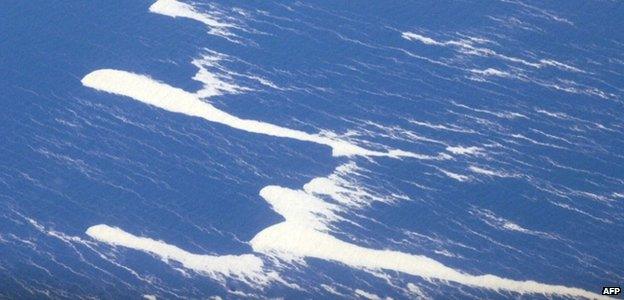Vast volcanic 'raft' found in Pacific, near New Zealand
- Published

A navy officer described the floating spectacle as the "weirdest thing" he had seen at sea
A vast "raft" of volcanic rocks covering 10,000 sq miles (26,000 sq km) of ocean has been spotted by a New Zealand military aircraft.
A naval ship was forced to change course in order to avoid the cluster of buoyant rocks, located 1,000 miles off the New Zealand coast.
The unusual phenomenon was probably the result of pumice being released from an underwater volcano, experts said.
One navy officer described it as the "weirdest thing" he had seen at sea.
Lieutenant Tim Oscar told the AFP news agency: "As far ahead as I could observe was a raft of pumice moving up and down with the swell.
"The [top of the] rock looked to be sitting two feet above the surface of the waves and lit up a brilliant white colour. It looked exactly like the edge of an ice shelf," the officer said.
Researchers aboard the ship, HMNZS Canterbury, suggest that the source of the pumice was an underwater volcano (seamount) known as Monowai, located to the north of New Zealand.
The pumice is likely to have been formed when lava from the seamount came into contact with seawater, and as it is less dense than water it quickly rises to the surface of the ocean.
Vicky Hards from the British Geological Survey said the raft of volcanic rocks on this scale was a "relatively unusual occurrence".
"Some 50-60 volcanic eruptions are reported per year in total, and out of these only a very small proportion are submarine," she told BBC News.
"Nevertheless, submarine volcanic eruptions are a relatively common phenomena, in fact many probably go unrecorded in the deep marine environment.
Dr Hards added that a previous example was close to Tristan da Cunha, a small group of small volcanic islands in the southern Atlantic Ocean.
"A small eruption occurred in 2004 and rafts of pumice were observed about a mile offshore, washing up on the beaches for the next weeks" she explained.
- Published13 May 2012
- Published2 September 2011